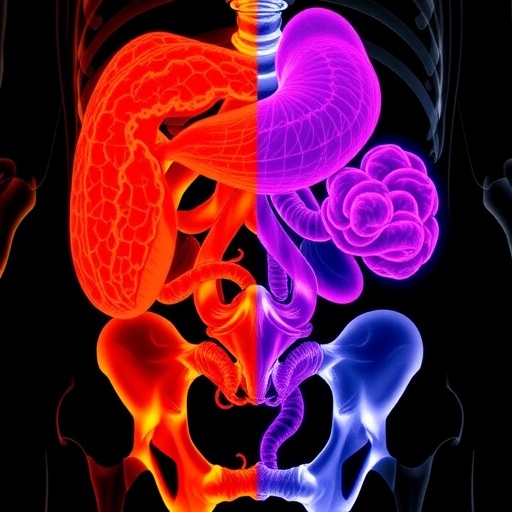In a groundbreaking development at the intersection of pediatric medicine and artificial intelligence, researchers Harijith and Pallavoor have unveiled a novel application of machine learning that promises to revolutionize the diagnosis of complex abdominal conditions in children. Their study, published in the prestigious journal Pediatric Research, introduces an innovative computational approach aimed at differentiating abdominal Immunoglobulin A (IgA) vasculitis without purpura from appendicitis — two conditions that often present with overlapping clinical symptoms but require profoundly different treatment strategies.
Abdominal IgA vasculitis, a systemic small-vessel vasculitis, is traditionally recognized by the presence of purpuric rash. However, instances lacking this hallmark symptom pose significant diagnostic challenges, frequently leading to misdiagnosis as acute appendicitis. Given that appendicitis often necessitates surgical intervention, whereas IgA vasculitis is commonly managed medically, the differentiation is not just academic but critically impacts patient outcomes. The researchers leveraged state-of-the-art machine learning algorithms to mine subtle clinical and biochemical data signatures that escape even seasoned clinicians’ scrutiny.
The team began by assembling an extensive dataset including clinical presentations, laboratory values, imaging findings, and patient demographics drawn from multiple pediatric centers. Utilizing advanced data preprocessing techniques, they ensured the quality and consistency of the inputs fed into machine learning models. The models were then trained to identify patterns that delineate abdominal IgA vasculitis without purpura from cases of appendicitis. This approach is especially pivotal because in typical practice, overlapping symptoms such as abdominal pain, nausea, vomiting, and elevated inflammatory markers create a diagnostic gray zone.
Central to the research was the deployment of ensemble learning methods, combining the predictive strengths of several algorithms to enhance diagnostic accuracy. These included gradient boosting machines, random forests, and deep learning neural networks. Importantly, the authors applied rigorous cross-validation techniques and independent cohort testing to prevent overfitting, ensuring that the model’s predictive power is robust and generalizable across diverse clinical settings.
The results demonstrated a remarkable leap in diagnostic precision, with the machine learning framework outperforming traditional diagnostic criteria significantly. More intriguingly, the algorithm identified novel composite biomarker signatures—subtle fluctuations in inflammatory profiles and temporal symptom patterns—that were hitherto unappreciated in the differential diagnosis process. These findings not only provide immediate practical utility but also open new avenues for understanding the pathophysiological nuances of IgA vasculitis manifestations.
One of the salient features of this study is its potential to reduce unnecessary appendectomies in pediatric patients. Currently, misdiagnosing abdominal IgA vasculitis as appendicitis can lead to unwarranted surgeries, burdening young patients with avoidable complications and healthcare systems with inflated costs. By integrating machine learning diagnostics into clinical workflows, physicians could make more informed, data-driven decisions, ultimately enhancing patient safety and resource optimization.
Moreover, the study addresses several technical challenges endemic to applying machine learning in medicine. The authors discuss strategies for managing missing data points, balancing class imbalances in training sets, and maintaining explainability of models—critical for clinician trust and integration into medical practice. They emphasize the importance of transparent algorithmic processes and propose visualization tools that translate complex model outputs into clinician-friendly insights.
The implications of this research extend beyond abdominal IgA vasculitis and appendicitis. It represents a template for leveraging artificial intelligence to decode multifactorial diseases with ambiguous presentations. This paradigm shift heralds a new era whereby diagnostic ambiguity can be substantially minimized by harnessing computational power, bringing precision medicine closer to everyday clinical reality.
In addition to validating their algorithm with retrospective data, Harijith and Pallavoor’s study outlines plans for prospective clinical trials. These trials aim to assess the real-world impact of the machine learning tool on clinical decision-making and patient outcomes. Integrating such AI-driven diagnostics into electronic health record systems could enable real-time risk stratification, guiding personalized therapeutic plans in acute care settings.
The authors also explore the ethical dimensions of AI in pediatrics, underscoring the imperative of safeguarding patient data privacy and circumventing algorithmic biases. They advocate for ongoing multidisciplinary collaboration between clinicians, data scientists, ethicists, and patients’ families to ensure equitable and responsible implementation of these technologies.
This landmark research aligns with broader movements in healthcare to embrace digital transformation. As machine learning and AI continue to mature, their deployment in pediatric diagnostics could address persistent gaps in early disease detection, standardize care approaches, and streamline clinical workflows. The study by Harijith and Pallavoor exemplifies the fusion of clinical expertise and computational innovation, showcasing how interdisciplinary efforts can unlock transformative solutions to enduring medical challenges.
Ultimately, this pioneering work offers hope that many children presenting with nonspecific abdominal pain might soon benefit from more accurate, less invasive, and timely diagnoses. The prospect of reducing surgical interventions while optimizing targeted therapies epitomizes the promise of machine learning in advancing pediatric healthcare. As this technology is refined and adopted, it may set a precedent for similar diagnostic conundrums, marking a significant stride towards a future where artificial intelligence amplifies human clinical judgment to improve lives.
Subject of Research: Differentiation of abdominal IgA vasculitis without purpura from appendicitis using machine learning
Article Title: Understanding and applying machine learning in differentiating abdominal IgA vasculitis without purpura from appendicitis
Article References:
Harijith, A., Pallavoor, S. Understanding and applying machine learning in differentiating abdominal IgA vasculitis without purpura from appendicitis. Pediatr Res (2025). https://doi.org/10.1038/s41390-025-04520-0
Image Credits: AI Generated




